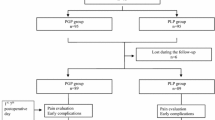Abstract
Purpose
Lichtenstein repair has been the gold standard in inguinal hernia surgery. The aim of this study was to investigate the role of mesh fixation in terms of postsurgical chronic pain and recurrence.
Methods
Sixty patients with primary inguinal hernias were treated between March 2007 and December 2008. Thirty patients underwent conventional Lichtenstein repair while a self-adhesive mesh was used for the second group. The primary outcome parameters were the rate of recurrence and chronic pain. The operating time, postoperative pain, complications, and time when patients returned to work were recorded.
Results
Fifty-one patients completed the survey. Early pain scores were lower in the self-adhesive mesh group. The main advantage of the self-adhesive mesh was the shorter operating time (23.70 ± 5.57 vs 36.90 ± 11.36, P = 0.006). Both techniques were almost identical in terms of long-term chronic pain (P = 0.294), and the rates of recurrence at the end of a median of 31 months’ follow-up were identical.
Conclusion
Self-adhesive mesh repair of inguinal hernias is superior to the conventional Lichtenstein method in terms of shorter operative time and less pain in the early postoperative period. The rates of chronic pain and recurrence are similar with the suture-fixed repairs.
Similar content being viewed by others
References
Amid PK, Shulman AG, Lichtenstein IL. Open “tension-free“ repair of inguinal hernias: the Lichtenstein technique. Eur J Surg 1996;162:447–453.
EU Hernia Trialists Collaboration. Mesh compared with nonmesh methods of open groin hernia repair: systematic review of randomized controlled trials. Br J Surg 2000;87:854–859.
Butters M, Redecke J, Köninger J. Long-term results of a randomized clinical trial of Shouldice, Lichtenstein and transabdominal preperitoneal hernia repairs. Br J Surg 2007;94:562–565.
Pokorny H, Klingler A, Schmid T, Fortelny R, Hollinsky C, Kawji R, et al. Recurrence and complications after laparoscopic versus open inguinal hernia repair: results of a prospective randomized multicenter trial. Hernia 2008;12:385–389.
van Veen RN, Wijsmuller AR, Vrijland WW, Hop WC, Lange JF, Jeekel J. Long-term follow-up of a randomized clinical trial of non-mesh versus mesh repair of primary inguinal hernia. Br J Surg 2007;94:506–510.
Mokete M, Earnshaw JJ. Evolution of an inguinal hernia surgery practice. Postgrad Med J 2001;77:188–190.
Bay-Nielsen M, Nilsson E, Nordin P, Kehlet H. Chronic pain after open mesh and sutured repair of indirect inguinal hernia in young males. Br J Surg 2004;91:1372–1376.
Kumar S, Wilson RG, Nixon SJ, Macintyre IM. Chronic pain after laparoscopic and open mesh repair of groin hernia. Br J Surg 2002;89:1476–1479.
Hansen MB, Andersen KG, Crawford ME. Pain following the repair of an abdominal hernia. Surg Today 2010;40:8–21.
Massaron S, Bona S, Fumagalli U, Battafarano F, Elmore U, Rosati R. Analysis of post-surgical pain after inguinal hernia repair: a prospective study of 1,440 operations. Hernia 2007;11:517–525.
Grant AM, Scott NW, O’Dwyer PJ. Five-year follow-up of a randomized trial to assess pain and numbness after laparoscopic or open repair of groin hernia. Br J Surg 2004;91:1570–1574.
Nienhuijs S, Staal E, Strobbe L, Rosman C, Groenewoud H, Bleichrodt R. Chronic pain after mesh repair of inguinal hernia: a systematic review. Am J Surg 2007;194:394–400.
Nikkolo C, Lepner U, Murruste M, Vaasna T, Seepter H, Tikk T. Randomised clinical trial comparing lightweight mesh with heavyweight mesh for inguinal hernioplasty. Hernia 2010;14:253–258.
Köninger J, Redecke J, Butters M. Chronic pain after hernia repair: a randomized trial comparing Shouldice, Lichtenstein and TAPP. Langenbecks Arch Surg 2004;389:361–365.
Smietanski M. Randomized clinical trial comparing a polypropylene with a poliglecaprone and polypropylene composite mesh for inguinal hernioplasty. Br J Surg 2008;95:1462–1468.
Klinge U, Klosterhalfen B, Muller M, Schumpelick V. Foreign body reaction to meshes used for the repair of abdominal wall hernias. Eur J Surg 1999;165:665–673.
Hollinsky C, Kolbe T, Walter I, Joachim A, Sandberg S, Koch T, et al. Comparison of a new self-gripping mesh with other fixation methods for laparoscopic hernia repair in a rat model. J Am Coll Surg 2009;208(6):1107–1114.
Champault G, Polliand C, Dufour F, Ziol M, Behr L. A “self adhering” prosthesis for hernia repair: experimental study. Hernia 2009;13:49–52.
Cobb SW, Kercher KW, Heniford BT. The argument for lightweight polypropylene mesh in hernia repair. Surg Innov 2005; 12(1):63–69.
Anadol AZ, Tezel E. Prospective randomized comparison of conventional Lichtenstein versus self adhesive mesh repair for inguinal hernia. Surg Endosc 2009:23:S315.
Chastan P. Tension free open inguinal hernia repair using an innovative self gripping semi-resorbable mesh. J Min Acces Surg 2006;2(3):139–143.
Chastan P. Tension-free open hernia repair using an innovative self-gripping semi-resorbable mesh. Hernia 2009;13:137–142.
Nixon JA, Preshaw RM, Hagen NA. Cooperative hernia study. Pain in the postrepair patient. Ann Surg 1996;224:598–602.
Paily A, Thornton M. Chronic pain following a Lichtenstein inguinal hernia repair: a clinical and legal dilemma. ANZ J Surg 2009;79:517–520.
Wijsmuller AR, van Veen RN, Bosch JL, Lange JFM, Kleinrensink GJ, Jeekel J, et al. Nerve management during open hernia repair. Br J Surg 2007;94:17–22.
Author information
Authors and Affiliations
Additional information
The early postoperative results of this technique were presented in part at the 2009 Congress of SAGES, Phoenix, AZ, USA.
Rights and permissions
About this article
Cite this article
Anadol, A.Z., Akin, M., Kurukahvecioglu, O. et al. A prospective comparative study of the efficacy of conventional lichtenstein versus self-adhesive mesh repair for inguinal hernia. Surg Today 41, 1498–1503 (2011). https://doi.org/10.1007/s00595-011-4545-8
Received:
Accepted:
Published:
Issue Date:
DOI: https://doi.org/10.1007/s00595-011-4545-8




